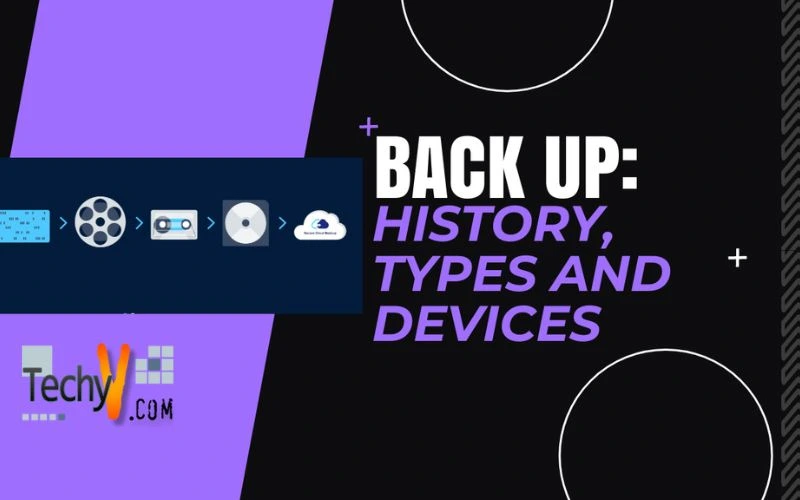Back up: History, Types and Devices
In our everyday life, a lot of things come and go, but we need something we can go back to for us to continue and base our decisions from. That is where the word back-up comes in. Back-up is an idiomatic expression that means ‘a reserve or a substitute’. This word is mostly used in the ‘Techy’ world, as what we call the fast-paced world of technology.
SPECIAL TYPES OF BACK UP
- Normal backup is also known as the full back up and the most usual type. Usually, full backups are operated formerly a week and are part of a general backup plan. Occasionally, full backup is performed behind the major adjust of the information on disk, for instance an operating system change or installation of a software. This is the backup type you would use if you want to protect every file in a given folder or drive. This backs up everything you want to regardless of what the archive says. Most of the time, you are given an option to choose every data, file or folder you want to back up like the system state data of the server from where the backup is being run.
The major advantage you would get from using this type of back up would be restoring the files in its fastest way. Though on the other hand, backing up is the slowest due to its storage space requirements are the highest.
- Archive bit is a tag that is within every file. In reality, it is set into a binary digit that is on or off in the file. Though, it doesn’t really tell us anything. Mainly, it lets the user back up its software knowing what needs designate backed up. This archive bit is relies on the direction given by the differential and incremental back up types.
- Incremental Back up is mainly backing up things that have distorted ever since the previous bursting back up. For example, you performed a normal back up on Monday, then an incremental back up after two days; the only files that would need backed up are those that have changed since Monday. And If the next day, someone deletes a file accidentally, you will have to restore the full back first then follow it up by the incremental backup from Wednesday in order to get your files back.
Unlike the normal back up, wherein it only takes a moment to restore, with incremental, it would take almost forever. Yet, backing up is the greatest since storage space supplies are small.
- Differential Back up that is commonly told as another name of Incremental back up. Differential backup is offering a center ground by backing up all records that contain updated ever since the final full backup. However, they only backup files with their archive bit or tag, or flag, up. and when a differential backup occurs it does not reset those record bits which denotes, if the following day, another differential backup arise, it will back up that folder yet again regardless of whether that file has been updated or not.
Just like full and incremental back up, it also have its advantages and disadvantages. Restoring is more rapid than restoring incremental back up. Backing up is further speedy than a complete back up since storage space provisions are slighter than for full back up. On the contrary, Restoring is slower than restoring from full back up and backing up is slower than incremental back up. This time the storage requirements are higher than incremental back up.
- Dump backups are not just ordinary file by file backups. Regardless of the file system on the hard drive, or even if there are data’s in the file system, it wouldn’t be affected. It examines files on an ext2 file system and determines which ones need to be backed up. At the same time, copies those file into a specified disk. The result and reasons for doing this are that with multiple levels, the information history can be extended in a cheaper way. Since most of the time, it takes a while to notice if a file has been deleted or corrupted.
- Level 0 to 9 backup is called the better edition of incremental backups. Level N backup implies restoring the whole thing that changed since the last time the identical or lower lever backup has been performed.
- .Network back up usually means backing up client to back up service. This means, the client mails the files to the server and the server inscribe them toward back up medium.
Back up gadgets… From then till now
1. Punch card back ups
Throughout the year 1951 when the first generation of digital computing appeared during UNIVAC I (Universal Automatic Computer) was put up by Mauchly and Eckert. Mainly, it acts as a space tube as its main logic element and rotates with magnetic drums for interior storage of information and files, sets plus punch cards to enter and externally store information.
Thus, punch cards can be considered as the first data storage device for back up.
2. Magnetic Tapes and Tape Back up
During the 1960’s, Magnetic tapes were developed. Magnetic tapes back then became an instant success and most popular because of the way it stores data in so far as 10,000 punch cards does.
Gigantic and little companies and yet home users began to generate backup tapes. First back up background and stratagem started to take place early on 1960. And since the product is known for its reliability, sell and small rate, it was known extensively in an instant.
3. Hard drives as well as Disk-to-Disk back up
It was in the year of 1956 when IBM initiated the former hard drive. Though, at first, it wasn’t considered as a good substitute for tape backups due to its elevated value large volume plus low storage capacity. But When 1980’s too early 1990’s arrived, it become a valid substitute and need for back ups. And up until today, its reign continuously in the market.
4. Floppy disks
In 1969 the earliest floppy disk came out of the marketplace, it’s flexible by means of being able to transfer data from one computer to another made it very widespread. And that is only aside from the fact of its low-cost. Floppy disks started with a read-only 8-inch disk that might amass 80kb of data. Yet, as year’s passes by, a rewritable disk has been developed and so the trend goes on; a smaller disk comes with advanced data aptitude. And because of all these facts, it became one of the mainly widespread backup media between house users and little companies.
5. Flash Drives
As of today, handy USB storage flash drives aren’t fresh to the humanity of back up. Users prefer having these for back up use because of the benefit of having to bring it anywhere you go due to its size. Not only that, it now can hold several times more than what a floppy disk can do and can even be compared to a CD-Rom due to its capacity to hold as much as it can. It’s not really tough to believe that it’s a powerful force in the data back up market.
6. Blu-ray Disks with HD-DVD
Blu-laser disks with organic dyes, for example the Sony Blu-ray format also Toshiba’s HD-DVD are notified to be the next creation to further attrition of fee detachable media beside with its limit of volume held for expansion and development. They are now measured as hopeful devices for records back up.
7. Network with On-line Back up solutions
Prolong development for back up is directly linked to the fruition of network and internet technologies. Now, home and worldwide networks lets a user remotely access its storage degree all above the globe.
- Evolution
- Local area network – allowing several computers to be at high-speed linked to a central computer with a large central at one place.
- File transport Protocol- allowing users to connect two computers to the internet while transferring data from one another remotely. As long as it has TCP/IP, it will let users to relocate preserve copies of data stuck between computers with no trouble.
- Network Joined Storage, premeditated to be connected to a conventional information network.
- Storage Are Network, planned to connect storages like disk array regulator also tape libraries.
- World Wide Web
No need to further discuss, back up storage is a major necessity now. It’s better to have everything secured than to regret losing your most important files for future use.

















